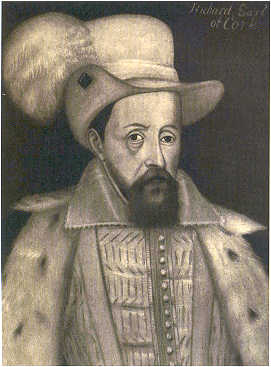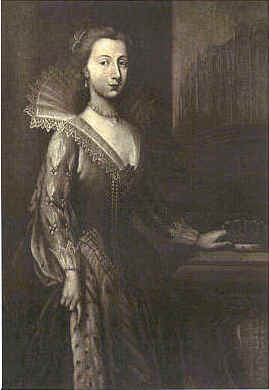| 2003 |

|
YEAR BOOK |
Charles Mollan
|
Ireland's greatest entrepreneur
Or - how our most eminent scientist was enabled to devote his life to science |

While our immediate reaction might be to apply these comments to recent manifestations of the phenomenon, we can go further back. A prime example of the type was Richard Boyle (1566-1643), the legendary 'Great Earl of Cork', who has been described as 'the prototype of a capitalist entrepreneur' (C3*). Bringing the nickname more up to date, we might christen him 'Ireland's Bill Gates', as we haven't produced anyone to a match him since.
Richard is particularly remembered as the father of Robert Boyle (1627-1691), his fourteenth child and youngest son with his second wife, Catherine (c1588-1630). Robert Boyle, often referred to as 'the father of chemistry', is known to school science students who must learn 'Boyle's law' (for an ideal gas at constant temperature, volume is inversely proportional to pressure). Robert is revered by historians of science for his key role in establishing the scientific method - he demonstrated that careful and reproducible experiments could lead to dramatic advances in scientific knowledge.
Robert was able to devote himself to the study of science (and alchemy and theology) because, as he put it himself, he was born 'in a Condition that neither was high enuf to proue a Temptation to Lazinesse, nor low enuf to discourage him from aspiring'. That this seventh son of a man who himself was the 'second son of a younger brother' (C4) could do what he wanted without worrying about the cost was due to his father's remarkable ability to amass money. Richard, credited as a man who performed 'a truly super-human feat of social leap-frogging' (C14), raised himself to a position in which he 'enjoyed income from rents far greater than that of any other subject of King Charles I' (C6).
Daddy
Richard Boyle (1566-1643) was born in Canterbury, Kent, the second son of Roger Boyle and his wife, Joan Naylor (DNB). Richard was educated locally, and attended what is now Corpus Christi College in Cambridge, but he didn't graduate. He acquired some legal and secretarial experience in London, but he wasn't getting anywhere fast so, in 1588, 'a penniless but ambitious young man went to seek his fortune in Ireland' (C5). In 1590 he got an appointment as a 'deputy escheator' - where he would have dealt with properties reverting to the Crown in the absence of legal heirs. He was thus in a position to discover flaws in land titles and to pass some of the titles on to himself at very low rents. He had the good sense to marry an heiress - Joan Aplsey - in 1595, thus augmenting his lands, and extending his property in Munster. Joan died in childbirth in 1598, but this left him free to make another advantageous marriage five years later - to Catherine, of whom more below.
His success wasn't achieved easily. He was imprisoned in Ireland and England on several occasions in the 1590s for embezzlement and theft (C5). He nearly went under when rebellion broke out in Ireland, and he was obliged to flee to England between 1598 to 1600. But on his return he received a royal pardon for those of his earlier actions which had exposed him to charges of fraud. He also bought, for �1,500 in 1602, 12,000 acres in Cork, Waterford and Tipperary, which had been granted to Sir Walter Raleigh (C6). He lived in Youghal, and then moved to Lismore Castle, and it was at Lismore that Robert was born.
So Richard the poacher turned gamekeeper to secure his estates. He built thirteen strong castles defended by well-armed bands of retainers. He set up lucrative manufacturing concerns. He kept 4,000 labourers on his lands, and he negotiated patents from the crown to protect his estates from any eventuality (DNB).
Meanwhile he was climbing the social ladder. He became Sir Richard Boyle in 1603, Lord Boyle, Baron of Youghal, in 1616, and Viscount Dungarvan and Earl of Cork in 1620 (DNB). He was appointed one of the two Lords Justice of Ireland from 1629 to 1633, Lord High Treasurer of Ireland from 1631, and Member of the English Privy Council in 1640. On the way to this social success, he had negotiated advantageous marriages with noble families in Ireland and England for most of his children. Alice married the Earl of Barrymore, Joan the Earl of Kildare, Katherine Viscount Ranelagh, and Mary the Earl of Warwick. Richard junior, in due course, became second Earl of Cork and Earl of Burlington, Lewis became Viscount Boyle of Kinalmeaky, Roger Earl of Orrery, and Francis Viscount Shannon (M299-300). To Robert's great relief, plans for him to marry and reside in Mallow, Co. Cork, came to nought, as did an inclination to join the army in 1644 (C37), from which his sister, Lady Ranelagh, 'the most renowned female intellectual of her generation' (C78), deflected him.
Always conscious of his lowly beginnings, Richard Boyle was at pains to put a different spin on things. He compiled his 'True Remembrances' in 1623 (updated in 1632), in which he pictured himself as a 'virtuous man free from ambition, whose wealth and possessions had come to him almost by default, and which he cherished only in so far as they could be employed to honour God, serve the king, strengthen the commonwealth and enhance the reputation of his family and posterity' (C19). The motto he chose was 'God's providence is mine inheritance'. It appears that he was 'so completely convinced by his own version of events that even those parts which we know to be pure invention assumed a subjective truth for himself' (C26). It might be noted that one of his critics, Thomas Wentworth, Earl of Strafford, appointed Lord Deputy of Ireland in 1632, recorded that he had 'never known [Cork] to deliver one truth' (C16). The actual position was somewhere in between, but Richard eventually had the satisfaction of surviving Strafford, who was executed in 1641 for 'subverting the fundamental laws of England and Ireland' (CIH588).
It is perhaps not surprising that the Great Earl had acquired enemies who wished to 'dive into the mystery [of the greatness of his estate], and how it came to pass' (C124). But there were advantages to having made your fortune in Ireland. It was a turbulent time in the history of these islands in the decades leading up to the beheading of Charles I in 1649. As the ideologies of those with power in England were changing, it was difficult to stay on side, but Richard seemed to be able to go with the flow and survive without taking extreme and unchanging positions. Initially, as would be expected, he identified with his native country, England, and indeed bought property in England and sought influence there. He was successful too, rising eventually, as already mentioned, to the important position of membership of the English Privy Council. But he was accepted in England as a man whose achievements had been in Ireland, and whose service to the crown would be there also. It is recorded (C125) that eventually he came to take pride in the description 'Irishman'.

Mammy
We don't know so much about Robert Boyle's mother, Catherine (or Katheryne) Fenton (c1588-1630). She was the daughter of Sir Geoffrey Fenton (c1539-1608) and Alice Weston, who were married in 1585. Sir Geoffrey, 'an honest, straightforward servant of the queen' (DNB), was Principal Secretary of State in Ireland from 1580, and Alice was the daughter of Dr Robert Weston, Lord Chancellor of Ireland from 1567 until his death in 1573 (DNB). Catherine was only about 15 when she married the 37-year-old Richard Boyle in 1603. Their first child, Roger (who died at the age of nine), was not born until three years later, but, after that, she was in a fairly constant state of pregnancy and childbirth, with 15 children born over a period of less than 23 years.
Unfortunately for Robert, his mother died at the early age of about 42 just after his third birthday, so he scarcely remembered her. But he described her as 'a Woman that wanted not Buty, & was rich in Vertue.....whose Death would question-less haue excessiuely afflicted him, had but his Age permitted him to know the Value of his Losse. For he wud euer reckon it amongst the Chieefe Misfortunes of his Life, that he did ne'er know her that gaue it him: her free and Noble Spirit (which had a handsome Mansion to reside in) added to her kindnesse and sweete carriage to hir owne, making her hugely regretted by her Children, & so lamented by her Husband' (M2&4).
It seems to have been a happy marriage, for the Great Earl later described Catherine as 'the crown of all my blessings' (C24), and he 'annually dedicated the Day of hir Death to solemne Mourning for it; but Burying in her Graue all thoughts of Aftermarriage, he rejected all Motions of any other Match, continuing a constant Widdower till his Death' (M4). While he admired her qualities - 'most religious, virtuous, loving and obedient' - it seems clear he wore the trousers. He closely supervised the household accounts, he selected the gowns and jewels for important occasions, and he would not allow anyone to give his wife a loan (C85). This may have been an initial consequence of their difference in ages, which then became a habit. It would have been exacerbated since Catherine's mother, Lady Alice Fenton, lived in her daughter's house (Alice was widowed in 1608), and she was closer in age to the Great Earl than was his wife (C119).
In general, it appears that the Great Earl's opinion of women was not high: 'Cork considered women to be unreliable because they were guided by emotion rather than by reason' (C85) and he was not slow to marry off his daughters to men who would enhance his status, without much regard to their wishes. This was made easier by negotiating their marriages at an early age - the average being a mere nine years - with their ages at actual marriage being between 15 and 19 (C89).
Behold the man
Thus Robert Boyle, arguably Ireland's most eminent scientist (and one of England's too: both countries have legitimate claims on him) had parents with many positive qualities, who contributed to his character and gave him the freedom to pursue his interests, which he did to such great effect.
References
* C stands for Canny; CIH for Connolly; DNB for Dictionary of National Biography (CD-ROM version); M for Maddison; illustrations are taken from Townshend.
Nicholas Canny, The Upstart Earl, Cambridge University Press, 1982.
S.J. Connolly (Editor), The Oxford Companion to Irish History, Oxford University Press, 1998.
R.E.W. Maddison, The Life of the Honourable Robert Boyle FRS, Taylor & Francis, London, 1969.
Dorothea Townshend, The Life and Letters of the Great Earl of Cork, Duckworth, London, 1904.